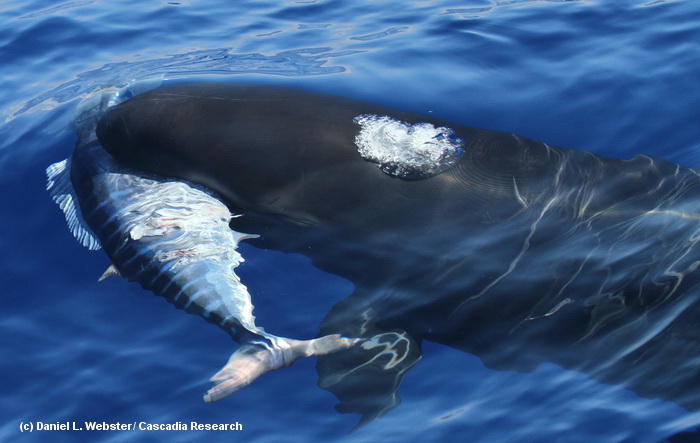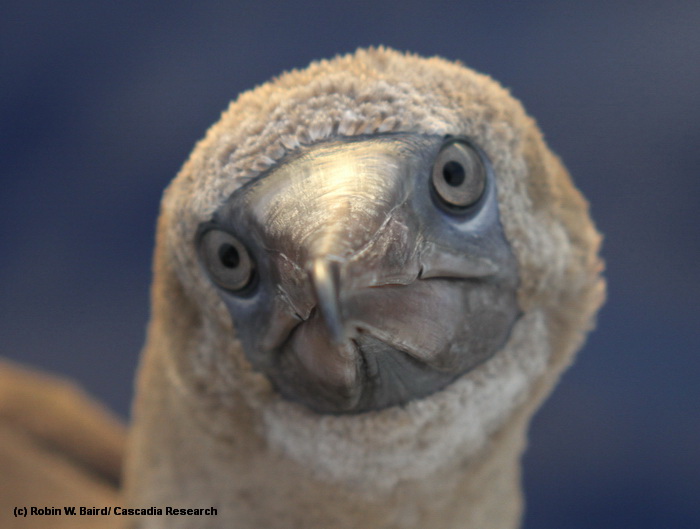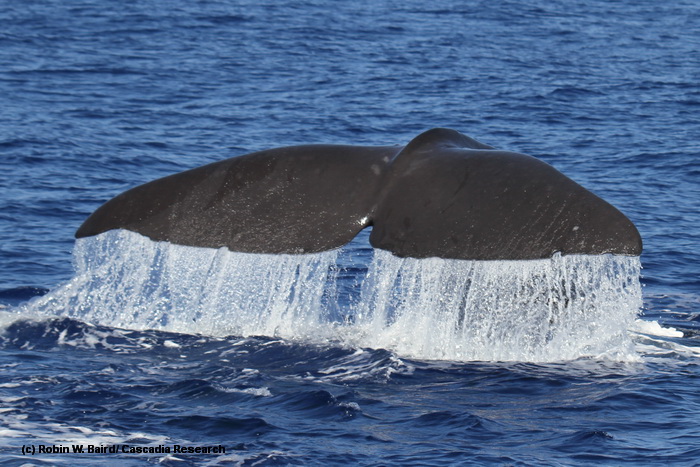Cascadia Research is undertaking a field project off the island of Hawai‘i from December 5-17, 2010, our fourth field effort this year (and the third off this island). Our primary goal for this project is to obtain information on movements and habitat use of false killer whales, but we will be working with most species of toothed whales we encounter, attempting to deploy satellite tags and obtaining biopsy samples (for toxicology and genetic studies) from most species. Other species that we are hoping to satellite tag are short-finned pilot whales, melon-headed whales, pygmy killer whales, Cuvier’s beaked whales, Blainville’s beaked whales, and sperm whales. We will also be obtaining photos for individual photo-identification catalogs of 10 species, and collecting squid and sightings of sea birds.
The research team includes Greg Schorr, Daniel Webster, Jessica Aschettino and Robin Baird of Cascadia, Dan McSweeney of the Wild Whale Research Foundation, Renee Albertson of Oregon State University and a number of volunteers. This work is primariliy being funded by a grant from the Pacific Islands Fisheries Science Center, with additional support from Dolphin Quest, the Northwest Fisheries Science Center, and the Naval Postgraduate School.
For more information see our Hawai‘i odontocete research page
Sign up to our Facebook page if you want to receive notices of when information is posted and updates on other Cascadia projects.
December 17th update

Short-finned pilot whale spyhopping, December 17, 2010. Photo by Jessica Aschettino.
Today was the last day of this field project and our last day on the water in Hawai‘i for 2010. This trip we spent 101 hours on the water over 12 days, covered 1,801 kilometers of trackline, had 30 encounters with 10 species of odontocetes, took 12,997 cetacean photos, collected 19 genetic samples (of 5 species), and deployed nine satellite tags. Overall a very good trip.

A map showing a sea surface height model for the last 30 days from the Naval Research Laboratory Global Ocean Analysis and Monitoring web site. This model shows how dynamic the ocean currents are around the main Hawaiian Islands, largely driven by the prevailing trade winds. Over the last month there has been a large clockwise (downwelling) eddy off the west side of the island, and a counter-clockwise (upwelling) eddy further offshore to the west. These oceanographic patterns must influence the distribution of whale and dolphins around the islands – during this trip we had no sightings of rough-toothed dolphins (typically our fifth-most frequently encountered species), and only three sightings of short-finned pilot whales (typically our most frequently encountered species) – it is likely that the distribution of both species has been influenced by the large eddies offshore.

These currents have also influenced the amount of debris off the island – during this trip we’ve collected five glass balls – Japanese fishing floats. In the last 10 and a half years of field work in Hawai‘i we’d only found four glass balls, so five in one trip is quite amazing!

Juvenile short-finned pilot whales rolling belly-up at the surface, December 17, 2010. Photo by Jessica Aschettino.

Short-finned pilot whale spyhopping, December 17, 2010. Photo by Mark Malleson.

Pantropical spotted dolphin, December 17, 2010. Photo by Daniel Webster.
December 15th update

False killer whale seen off the island of Hawai‘i, December 15, 2010. Photo by Daniel Webster.
Today we found two false killer whales from the Hawaiian insular population off the northwest part of the island. Although we did not see any of the satellite tagged individuals from December 11, the two individuals were likely close to the rest of the group, based on the locations received from the satellite tags. The individual above, HIPc164 in our catalog, was first documented May 26, 2003 off O‘ahu and has been seen a number of times since off both O‘ahu and the island of Hawai‘i.

Striped dolphins off Kona, December 15, 2010. Photo by Daniel Webster. We also encountered another group of striped dolphins, as well as a a group of pantropical spotted dolphins.
December 14th update

Map showing movements of satellite-tagged false killer whales since they were tagged on December 11th. The whales moved up the Kona coast today and we covered 176 kilometers trying to find them, but the weather did not cooperate (we experienced primarily Beaufort 3 and 4 conditions), and the time-delay in order to obtain the satellite locations (typically an hour or more) left us searching for the whales without success.

Adult pantropical spotted dolphin, December 14, 2010. Photo by Daniel Webster. We did find three different groups of pantropical spotted dolphins today, and collected two samples for toxicology analyses to be undertaken by the National Institute of Standards and Technology.

Juvenile pantropical spotted dolphin, December 14, 2010. Photo by Daniel Webster.

A well-marked adult pantropical spotted dolphin, December 14, 2010. Photo by Daniel Webster.

Flying fish, December 14, 2010, photo by Daniel Webster.
December 13th update

Striped dolphins off Kona, December 13, 2010. Photo by Robin Baird. Today we encountered our 10th species of odontocete for the trip, a group of about 15 striped dolphins. Striped dolphins are typically found only in deep offshore waters in Hawai‘i, typically deeper than ~3,000 m. For more information about striped dolphins in Hawai‘i see our web page for that species.

We also collected two squid found floating at the surface, probably brought up to the surface by deep-diving predators such as beaked whales or pilot whales. These squid will be sent to Bill Walker at the National Marine Mammal Laboratory for identification, and samples will be archived for genetic and stable isotope studies.
December 12th update

Juvenile bottlenose dolphin off Kona, December 12, 2010. Photo by Mark Malleson.
Today was our 7th day on the water for this trip, and we encountered our 8th and 9th species of odontocetes for the trip. Shortly after leaving Honokohau Harbor we encountered a pair of bottlenose dolphins. We then headed north trying to catch up with our satellite-tagged false killer whales (we had locations west of Kawaihae at ~6:00 hrs), but they had moved out of our range.

Adult bottlenose dolphin, December 12, 2010. Photo by Jessica Aschettino. For more information on bottlenose dolphins in Hawai‘i see our web page for that species.

Adult male short-finned pilot whale, December 12, 2010. Photo by Robin Baird.
Short-finned pilot whales are the most-frequently encountered species of odontocete in our work, representing almost 25% of all odontocete sightings. Yet today was our first encounter with this species this trip – on our way back we encountered a group of seven individuals, were able to photo-identify all of them, and we deployed a satellite tag on one individual to track movements. For more information on short-finned pilot whales in Hawai‘i see our web page for that species.
December 11th update

False killer whale with ‘ono, December 11, 2010. Photo by Daniel Webster.
Today we encountered a group of false killer whales from the Hawaiian insular population. The whales were spread over an area of at least 4 kilometers by 10 kilometers, and we counted about 26 individuals. We were able to photo-identify almost all of the individuals present, and also deployed four satellite tags, including two location/dive tags.

A false killer whale, showing the protruding melon characteristic of adult males. Photo by Robin Baird. This individual is HIPc204 in our photo-ID catalog, first documented in our research in 2004.

False killer whale trying to stun a mahimahi. Photo by Robin Baird. During the encounter we observed predation on at least seven different fish, including three mahimahi. One of the predation events was quite prolonged, with the whales spending time apparently trying to stun the fish before eating them.

Fasle killer whale taillobbing to try to stun a mahimahi. Photo by Robin Baird. For more information on false killer whales in Hawai‘i see our web page for that species.

We also had a juvenile red-footed booby land on our boat. Photo by Robin Baird.
December 10th update

A large storm system is moving through the islands, and although we are only on the edge of the system we are staying on land for a while to see where it moves.

Meanwhile the sperm whale tagged on December 8th has moved south of our study area. The two satellite-tagged Cuvier’s beaked whales remain off the southwest side of the island. Yesterday we had no cetacean sightings, despite 100 kilometers on the water.
December 8th update

Sperm whale fluking, December 8, 2010. Photo by Robin Baird. Today we encountered a group of about 16 sperm whales offshore of Kona, comprised of females, juveniles and calves. We were able to get identification photos of several individuals in the group, three skin samples for genetic studies, and also deployed a satellite tag on one individual to track movements.

Sperm whale fluke, showing the distinctive markings on the trailing edge of the flukes used to identify individuals. Photo by Jessica Aschettino. The fluke photos we obtained will be sent to the Southwest Fisheries Science Center, for addition to their sperm whale photo-identification catalog.

A very cooperative sperm whale next to our boat, December 8, 2010. Photo by Robin Baird. For more information on sperm whales in Hawai‘i see our web page for that species.

A close up of the dorsal fin of one of the individual sperm whales, with cyamid lice. Photo by Jessica Aschettino.

Close-up of the nose of a sperm whale, December 8, 2010. Photo by Robin Baird.

A very well-marked dwarf sperm whale, December 8, 2010. Photo by Robin Baird. We also encountered a group of four dwarf sperm whales, and were able to get identification photos of two of the individuals for comparison to our photo-ID catalog. For more information on dwarf sperm whales in Hawai’i see our web page for that species.
December 7th update

Adult female Cuvier’s beaked whale surfacing, December 7. Photo by Renee Albertson.
A good day on the water. Today we encountered a group of three Cuvier’s beaked whales. We were able to get good identification photos of all three individuals, we deployed two satellite tags, and obtained one genetic sample.

This individual, HIZc052 in our photo-ID catalog, has previously been documented off the island in four different years – 2006, 2007, 2008, and 2009. Photo by Annie Douglas. There is a small resident population of Cuvier’s beaked whales off the island – we have been able to estimate the size of the population using photo-identification at only about 52 individuals. For more information on Cuvier’s beaked whales see our beaked whale web page.

Cuvier’s beaked whale with satellite tag on dorsal fin. Photo by Annie Douglas.

We also encountered two hammerhead sharks, and four groups of spotted dolphins. Photo by Daniel Webster.

Jellyfish, December 7, 2010. Photo by Annie Douglas.
December 6th update

Melon-headed whales, December 6, 2010. Photo by Jessica Aschettino.
Today we encountered a group of melon-headed whales, estimated at 210 individuals. We were able to obtain photos for individual identification of almost half the individuals present. Jessica recognized many of the individuals in the group from her graduate work with this species – the group is part of the Hawai‘i Island resident population.

This individual melon-headed whale, HIPe1585 in our catalog, was first documented off the island of Hawai‘i in April 1988. Interestingly you can see a large number of very faint scars from cookie-cutter shark bites visible on this individual.

Melon-headed whales and humpback whale, December 6, 2010. Photo by Daniel Webster. A number of the melon-headed whales were harassing a humpback whale, with the humpback “chuffing” when exhaling, something they typically do when agitated.

Melon-headed whales showing the difference in head shape with age. The middle individual (on the left) is a juvenile, with a relatively pointed head, while the individual in the foreground is adult-sized, with a very rounded head.

Melon-headed whale, December 6, 2010, photo by Jessica Aschettino. For more information on melon-headed whales in Hawai‘i see our web page for this species.
December 5th update

A Leach’s storm petrel off Kona, December 5, 2010. Photo by Daniel Webster.
Today we covered 155 kilometers off the Kona coast, mostly in good sea conditions. We headed south in about 3000 meters of water, and north in about 1200 meters, but despite covering a wide area our only odontocete sighting was a large group of spinner dolphins, nearshore north of the harbor just before we headed in.

Spinner dolphin spinning, to remove remora, December 5, 2010. Photo by Greg Schorr.

An abnormally-pigmented spinner dolphin next to a normally-pigmented spinner dolphin, December 5, 2010. Photo by Annie Douglas.
December 4th update

A graphical weather forecast for the island for December 5th. If the forecast is accurate (they rarely are), it should be a good day tomorrow. We leave from Honokohau Harbor, just north of the red dot on the west side of the island indicating Kailua-Kona.

Five of the satellite tags deployed during our October O‘ahu field project are still transmitting, including four short-finned pilot whales, and one false killer whale. The false killer whale is the eastern-most of the whales shown in this map, possibly heading towards our study area off the big island. Movements are shown for about the last two days.
Photos on this page taken under NMFS Scientific Research Permits (Nos. 731-1774 and 774-1714). All photos are copyrighted and should not be used without permission.